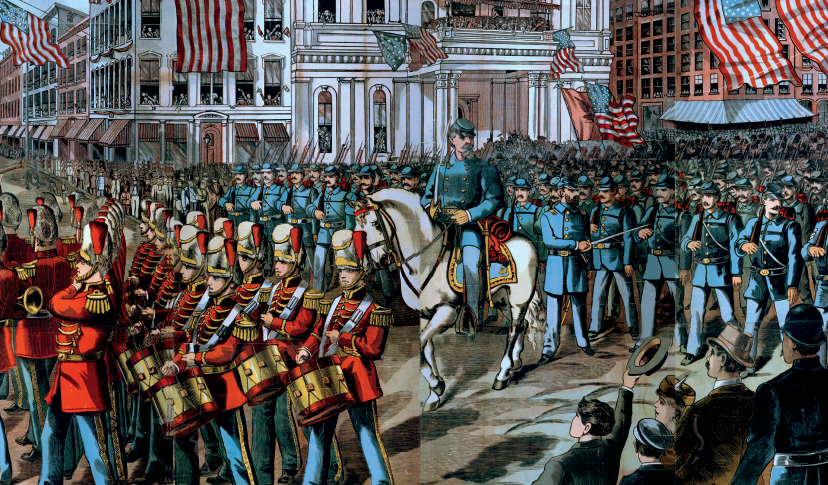A Civil War Drummer
William Bircher lived with his family near St. Paul, Minnesota, when the U.S. CivilWar (18611865) began. Like many 15-year-olds, William was excited about the war.He wanted to become a soldier in the Union Army and help defeat the Confederacy .
People in the northern states had a different way of life compared to people in thesouthern states. Northerners said they didnt need slaves to help them earn money.They thought the national government should make slavery illegal. Southerners saidthey needed slaves to help grow and harvest crops. They thought each state shouldmake its own laws about slavery.
People in the South were concerned Abraham Lincoln would take away states rightson issues such as slavery. On December 12, 1860, South Carolina became the firststate to leave the United States. Ten more southern states quickly followed. On April12, 1861, Confederate soldiers fired on Union troops who refused to leave Fort Sumterin Charleston, South Carolina. The Civil War had begun.
Unionthe Northern states that fought against the Southern states in the U.S. CivilWar
Confederacythe Southern states that fought against the Northern states in the U.S.Civil War
Minnesota officials soon began forming the Second Minnesota Regiment . William triedseveral times to join this regiment, but was turned away because of his age. FinallyWilliam was allowed to enlist as a drummer boy.
Many of the 3 million Americans who fought in the Civil War were boys. Both the Unionand the Confederacy required soldiers to be 18 years old, but many boys lied abouttheir ages. Other boys like William were allowed in as musicians. The Civil War wasthe bloodiest war in all of North American history. About 620,000 men and boys losttheir lives. Nearly 500,000 others lost limbs or suffered wounds.
Williams life was spared, and he was not wounded. But he learned that war is nota fun adventure. In his diary he wrote about the sacrifices, dangers, and hard workof war.
William Bircher in 186
Union soldiers were attacked at Fort Sumter, as shown in this illustration from 1861.
regimenta military unit
The Diary of William Bircher 18611865
July-August, 1861
... I had made several attempts to get into the regiment but, not being over fifteenyears of age and small in size, was rejected. But Captain J.J. Noah, of Company K,seemed to think I would make a drummer, as the company was in need of one. I wasthen taken to the office of mustering-officer Major Nelson and, after being questionedvery carefully in regard to my age, was not accepted until I should get the consentof my parents ...
... The happiest day of my life, I think, was when I donned my blue uniform and receivedmy new drum. Now, at last, after so many efforts, I was really a full-fledged drummerand going South to do and die for my country if need be ...
officers from the 1st Minnesota Volunteers regiment at Fort Snelling in 1861
This collection of diary entries was created by William years after the Civil War.In some instances, diary entries are taken word for word from the diary William keptas a drummer in the Civil War. In other entries, William writes about this time inhis life looking back as an adult.
Because Williams diary appears in its original form, you will notice misspellingsand mistakes in grammar. To make Williams meaning clear, in some instances, correctionsor explanations within a set of brackets follow the mistakes. Sometimes text hasbeen removed from the diary entries. In these cases, you will notice three dots ina row, which are called ellipses. Ellipses show that words or sentences are missingfrom the text.
October 14, 1861
... We found the city [St. Paul, Minnesota] ablaze with bunting and so wrought upwith excitement that all thought of work had been given up for that day.
As we formed in line and marched down the main street towards the river, the sidewalkseverywhere were crowded with people, with boys who wore red, white, and blue neckties... and girls who carried flowers with women who waved their handkerchiefs ...
A poster, created around 1880, shows Union soldiers marching through a city streetto join the Civil War.
buntingsmall flags joined by a string and used for decoration
Regiment Bands
Each Civil War regiment had its own band. The bands practiced every day and oftencheered the troops with concerts. Nearly 0,000 musicians served in the Union Armyand about 20,000 served in the Confederate Army.
Though musicians did not fight, drummers did serve on the battlefield. Drumbeatscommunicated orders to the soldiers, telling them when and how to move. In the thicksmoke of gunfire, drumbeats helped soldiers locate their units. Hundreds of drummerswere killed as they provided drumbeats in the direct line of enemy fire. Thousandsmore drummers were wounded in battle.
This illustration, printed in Harpers Weekly in 1863, shows drummers playing ata Union camp during the Civil War.
January 15 [1862]
... We made a long march, and at night found ourselves in the wild woods withoutfood or shelter and a long distance in advance of our wagons. Our pickets were postedwithin two miles [3 kilometers] of the enemy. We had a heavy rain the night before,and it had rained at times as we marched ...
January 19
In a few minutes our regiment was ordered on to the field of battle. We marched bythe right flank, up the main road, then made a left oblique movement, then regimentalfront, and
double-quick time until we met the Tenth Indiana. Falling backthey having run outof ammunition our regiment charged up to a rail fence, and here occurred a hand-to-handconflict: the rebels putting their guns though the fence from one side and our boyfrom the other. The smoke hung so close to the ground on account of the rain thatit was impossible to see each other at times ...
Williams regiment was ordered to the Battle of Mill Springs in Kentucky in 1862.Confederate troops had attacked the Tenth Indiana Regiment at Mill Springs.
This painting from 1862 shows the Battle of Mill Springs in Kentucky.
picketa detached group of soldiers guarding the troops against a surprise attack
ammunitionbullets and other objects that can be fired from weapons
April 1862
The battlefield was strewn with the wreck and carnage of war. Caissons , dismountedcannon, and dead artillary horses and their dead riders were piled up in heaps, andthe warm sun caused a stench that was almost unbearable ... No historian can everdepict the horrors of a battlefield ... Squads of men ... digging trenches, rollingthe dead in, and covering them up with ... dirt, only to be washed off by the firstrain, leaving the bones to be picked by the buzzards and crows ...


















